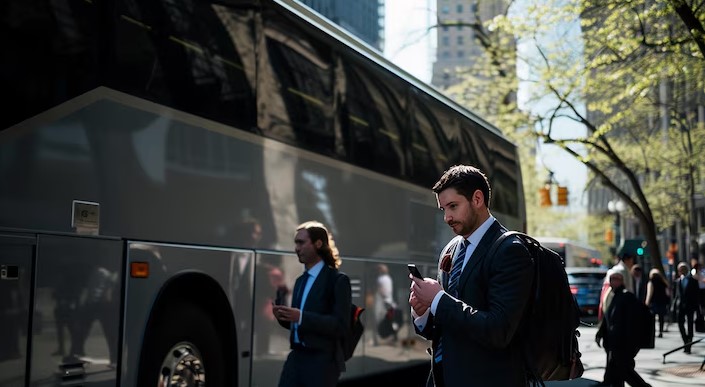
Transportation is one of the most fundamental things to consider if you want to plan a family vacation. In bigger families or groups, it would be more convenient to rent a bus, but always remember that safety comes first. Be it family bus rental services or private bus transport, knowing about their safety measures is a sure guarantee for a smooth and enjoyable experience for all members. This guide shall outline the required safety tips and guidelines for family bus rentals so you make an informed choice.
1. Choose a Reliable Bus Rental Company
This first step to safety for your family is choosing a reliable bus rental company. Since most have offers from renting family vacation bus, not all companies follow the safety requirements.
How to Choose Your Company:
- View reviews and testimonials of previous clients.
- Make sure the company has a license and insurance
- The drivers are experienced and qualified
- Are aware of and can give details of the condition and history of their fleet.
By doing your research you will be able to avoid using companies that take extreme measures to save a few dollars when it comes to safety measures. A reputable company will ensure that their buses are well taken care of, which largely reduces the prospects of an accident or mechanical failure.
2. Inspect the Bus Before the Trip
Before boarding the bus, you must check that this bus is in excellent condition. Though most of the family vacation bus rental companies inspect their buses regularly, it doesn’t hurt to check it once again to ensure your family a total safety.
Check List
- Seatbelts: All seats must have working seatbelts.
- Brakes and Tires: Check for wear and tear.
- Emergency Exits: Ensure that all emergency exits are marked and functioning.
- Air Conditioning and Heating: Verify that the climate control is in good working order, especially on long trips.
- First Aid Kit: Confirm that it has a complete first aid kit
- Inspect the Bus
Checking the bus might add an extra step but is imperative to ensure that you are safe, as well as your family members, for the entire duration of the trip.
3. Inspect Safety Features
The present buses are always equipped with various safety features to protect people in case of an emergency. Checking on the safety features your hired bus has in store for you is essential, especially when embarking on a family trip.
Safety Features:
- Anti-lock Braking System (ABS): This prevents the bus from skidding during its sudden stops.
- Stability Control: Enhances the bus stability, especially during rain or frosty conditions.
- Emergency Exits and Lighting: The presence of well-illuminated exits simplifies evacuation in case of an emergency.
- Fire Extinguisher: A fire extinguisher is most beneficial if it is available and accessible during a fire.
These are key features to have if you are heading to very remote places or where the driving conditions are not very friendly. Ensure that you request the company to provide you with an all-inclusive list of the safety aspects of the bus before you book.
4. Safety of the Driver’s Qualifications
A responsible driver is a great determinant of your safety during a trip. Therefore, before embarking on your journey, ensure that the bus driver you lease is adequately trained and experienced in handling the type of vehicle you are leasing.
Driver Requirements
- CDL: Ensure that the driver is licensed with a valid CDL, which is legally required for large vehicles.
- Experience: Ensure that the drivers have a minimum of five years of experience in driving buses or similar large vehicles.
- Clean Driving Record: Request the agency to confirm whether there is no record of any traffic violation or accidents of the driver.
- Background Check: Some companies offer the services of drivers who have already gone through background checks for security reasons.
Add to the above, the driver must be quite conversant with the route you shall use. He must also have a driving history in different weather conditions. You want an individual who, once behind the wheel, is professional and also capable of dealing with unexpected situations at hand.
5. Clear Safety Rules for the Users
While the driver is responsible for safety, passengers also play a role in creating a safe environment for the journey. Building a code of regulations before boarding may prevent many mishaps and accidents.
Safety Rules to Adhere To:
- Sitting: Instruct all the passengers to sit while the bus is on the move.
- Seat belts: Make sure all of them are buckled up even though it might not be mandated by law.
- Keep Aisles Clear: No luggage or personal items are allowed to block the aisles.
- Don’t Interrupt the Driver: Don’t talk loud or do anything which may distract the driver.
- Emergency Precautions: Tell the rider to open the emergency doors and tell him where he can find the safety devices, such as the first-aid kit and the fire extinguisher.
By elaborating these rules at the outset, you reduce the possibilities of accidents that you could have otherwise avoided.
6. Design Rest Stops
Long travel by road is exhausting for the driver as well as the passengers. To prevent the risk of drowsiness, rest stops provide a break where you can check the bus and ensure everything is in the right place.
Advantages of Rest Stops:
- Driver Drowsiness: Rest stops can help the driver take some time to regain energy levels and stay alert.
- Stretching: The passengers could stretch their legs and keep off discomfort while taking long sitting periods.
- Bus Inspection: Take advantage of a rest stop and inspect for worn tyres, braking ability, and other components of the bus.
Planning rest stops every two to three hours is an easy yet effective way to make road travel safer. It also keeps passengers comfortable and prevents the driver from falling asleep and causing accidents
7. Emergency Preparedness
They might take place even if one has planned everything. Hence, prepping up for emergencies is the secret to the safe experience of a family vacation bus rental.
Emergency Preparation
- Know Nearby Hospitals: Find hospitals along your travelling route in case of a medical emergency.
- Weather Condition: Get updates on weather conditions to avoid travelling under harsh weather conditions.
- Communication Plan: Have all employees take a cell phone to work with a fully charged one, if possible. Identify all the numbers employees might want to call in an emergency.
Also, having a person responsible for dealing with emergency procedures ensures that everyone will remain calm and act accordingly during an unexpected event.
8. Obey Local Traffic Laws
Different regions may have varied traffic laws, particularly for buses. It will provide knowledge of specific regulations and requirements of areas to prevent legal issues and safety risks.
Key Traffic Laws to Remember:
- Speed Limits: Follow what is posted on the sign, most especially in places that are strict in dealing with large vehicles.
- Bus Lanes: Use lane lanes where necessary.
- Parking Restriction: Be aware of places where you may park the bus and not breach local bylaws.
A responsible driver would always take into account the specific traffic laws that concern road safety and ensure that not only himself or herself, but also others on the road are secure.
Conclusion
Safety is key when renting a bus for a family vacation. You can assure the safety of the rental process by selecting a credible company, inspecting the vehicle, ensuring the drivers are qualified and sober, and following the set guidelines. With these tips and guidelines from Family Bus Rental Safety, you can now relax and have fun with your loved ones without worrying about safety concerns.



